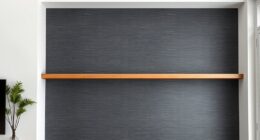Copper cookware is stunning and adds a touch of elegance to your kitchen with its warm shine and timeless style. Its quick heat response and even distribution help you cook with precision. However, it demands regular maintenance, like polishing and re-tinning, to keep its shine and prevent tarnishing. If you’re willing to put in the effort, copper’s beauty and performance are worth it. Discover how to balance style and upkeep for your perfect cookware.
Key Takeaways
- Copper cookware offers stunning visual appeal with a warm, reflective surface that enhances kitchen decor but requires regular polishing to maintain shine.
- Its exceptional thermal conductivity provides precise temperature control, ideal for delicate cooking tasks, but demands frequent cleaning to prevent tarnish.
- The high cost and ongoing maintenance, including re-tinning and polishing, make copper cookware a luxury choice that balances beauty with effort.
- Proper storage and gentle handling are essential to prevent scratches and patina development, adding to its high-maintenance reputation.
- Alternatives like clad or stainless steel-lined copper pans offer similar performance with less upkeep, appealing to those prioritizing style with lower maintenance.
The Allure of Copper: Why It Remains a Kitchen Favorite

Have you ever wondered why copper cookware continues to captivate home chefs and professional cooks alike? Its stunning, warm metallic shine instantly elevates any kitchen with timeless elegance. Copper cookware’s rich, burnished appearance makes it both functional and decorative, often displayed on open shelves or hung as a statement piece. Copper naturally develops a patina that adds unique charm, making each piece one-of-a-kind. Inside, many copper pots feature a stainless steel interior, ensuring durability and easy cleaning, while some have a tin lining for traditional craftsmanship. This combination of striking visual appeal and practical design keeps copper at the top of culinary favorites. Proper care and maintenance, including cleaning techniques, help preserve its beauty and functionality over years of use. Additionally, the historical craftsmanship involved in creating authentic copper cookware underscores its enduring appeal and value. Regular polishing can help maintain its shiny finish and prevent tarnishing, preserving its aesthetic appeal over time.
The Practical Benefits of Copper Cookware

Copper cookware gives you precise temperature control, so your dishes turn out just right every time. Its rapid heating response means you can adjust heat instantly, saving time and energy. Plus, its elegant look adds a touch of sophistication to your kitchen. Additionally, the color accuracy of copper cookware ensures that visual cues during cooking are reliable, helping you monitor and perfect your dishes with confidence. The global influence of copper cookware in culinary traditions highlights its importance in professional and home kitchens alike. Maintaining its stunning appearance also requires proper care and maintenance, which can be a rewarding part of owning high-quality cookware.
Precise Temperature Control
Thanks to its exceptional thermal conductivity, copper cookware responds almost instantly to temperature changes, giving you precise control over your cooking. This means you can:
- Adjust heat levels quickly, from a gentle simmer to a vigorous boil, without delay.
- Achieve even heat distribution, preventing hot spots and ensuring your food cooks uniformly.
- Fine-tune the precise temperature needed for delicate tasks like melting chocolate or simmering sauces.
- Utilizing natural signs like cloud formations can help you plan outdoor cooking sessions by predicting weather conditions that might affect your kitchen environment.
- Leveraging testing tools and adhering to best practices ensures your cookware maintains optimal performance and safety over time. Proper maintenance, such as regular polishing, also enhances copper’s conductivity, ensuring consistent cooking results.
With copper’s high thermal conductivity, your cooking becomes more efficient and accurate. You’ll notice better control over heat, reducing energy waste and minimizing food waste caused by uneven cooking. Copper cookware ensures you’re always in command, making it ideal for recipes that demand tight temperature regulation.
Rapid Heating Response
Because of its exceptional thermal conductivity, copper cookware heats up and cools down considerably faster than other materials, such as stainless steel. This rapid heating response allows you to adjust the heat instantly, thanks to superior heat conduction across the copper exterior. The quick temperature changes help prevent overcooking and burning delicate ingredients like sauces or chocolates. With copper’s immediate reaction to stove adjustments, you gain precise control during different cooking stages, from searing to simmering. Additionally, copper cookware often features advanced temperature controls, which further enhance cooking precision. Here’s a quick comparison:
| Material | Heat Conduction (W/m·K) | Response Time | Hot Spots |
|---|---|---|---|
| Copper | 400 | Fast (3-5x stainless) | Minimal |
| Stainless Steel | 15-25 | Slower | More likely |
| Aluminum | 200-250 | Fast | Few hot spots |
This responsiveness makes copper cookware a practical choice for accuracy and efficiency. This quick responsiveness is especially beneficial for cooking delicate dishes that require precise temperature control.
Elegant Kitchen Aesthetics
Adding copper cookware to your kitchen instantly elevates its visual appeal, blending timeless elegance with functional beauty. A well-curated copper collection can transform your space into a sophisticated haven. Picture these elements:
- Polished copper pots and pans reflecting light, creating a warm, inviting glow.
- Decorative pieces that serve as eye-catching accents on open shelving or countertops.
- An ambiance enhanced by the natural patina that develops over time, adding character or a polished shine based on your preference.
- Because copper reacts to environmental factors, maintaining its appearance often involves understanding copper tarnishing techniques, which can help you develop a deeper appreciation for the beauty and craftsmanship of your cookware over time.
- Regular cleaning and copper maintenance are essential to preserve its stunning luster and prevent tarnishing, especially for cookware in frequent use. Incorporating proper cleaning methods can extend the lifespan of your cookware and keep it looking pristine.
- Understanding architectural solutions can also inspire innovative storage and display options that enhance your kitchen’s aesthetic and functionality.
The High-Maintenance Nature of Copper Pans
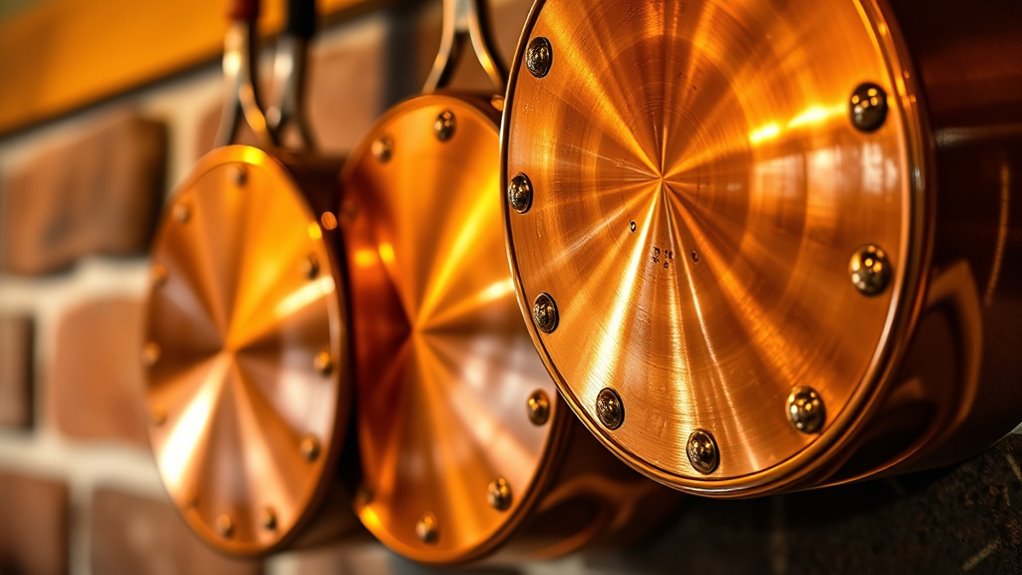
Copper pans demand regular upkeep to keep them looking their best. You’ll need to polish them roughly every six months to maintain their bright, shiny finish and prevent tarnishing. The tin lining in traditional copper cookware also requires attention; it needs re-tinning approximately every 10 years or when signs of wear appear, which involves professional reapplication. Copper reacts with acidic foods like tomatoes and wine, so you must clean the pans carefully and avoid prolonged contact to prevent corrosion and damage. Proper storage in a dry, cool place is crucial to prevent oxidation and the formation of patina, which can darken or green the surface over time. Additionally, using metal utensils can scratch the surface, making gentle handling and vigilant maintenance essential.
Tips for Keeping Copper Shine Bright and Beautiful
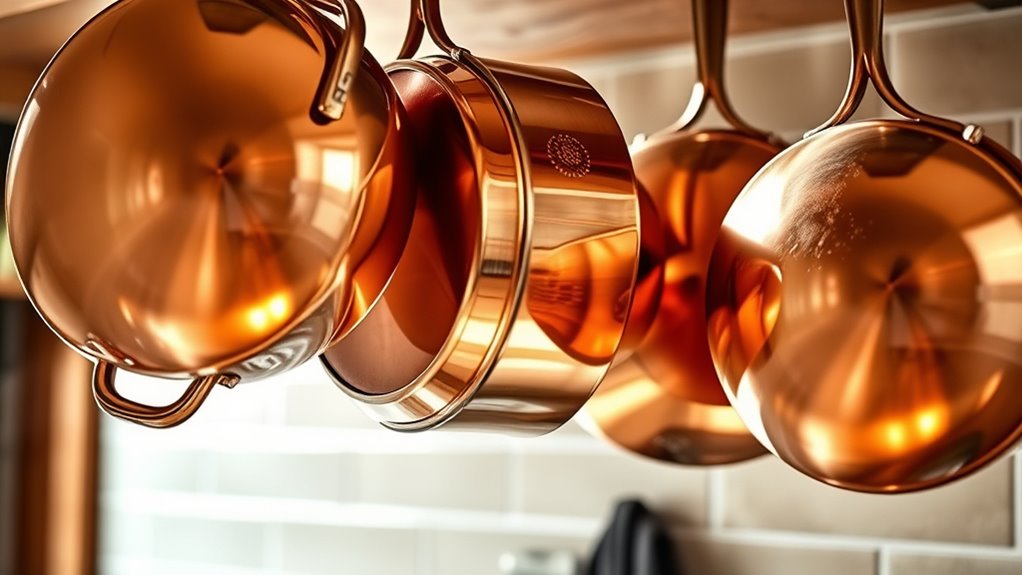
Maintaining the bright, lustrous appearance of your copper cookware involves regular care and smart cleaning techniques. To keep your copper cookware looking its best, follow these cleaning tips:
- Polish your copper cookware every six months with lemon juice and salt or a commercial copper polish to maintain shine.
- Use soft sponges or cloths instead of abrasive scrubbers to prevent scratching the tin lining.
- Store your copper pots in a dry, cool place to avoid oxidation and patina buildup, which dulls their appearance.
After cleaning, applying a thin layer of mineral oil or beeswax can protect the surface and enhance its natural luster. Consistent care guarantees your copper cookware remains stunning and radiant.
Balancing Aesthetics With Routine Upkeep
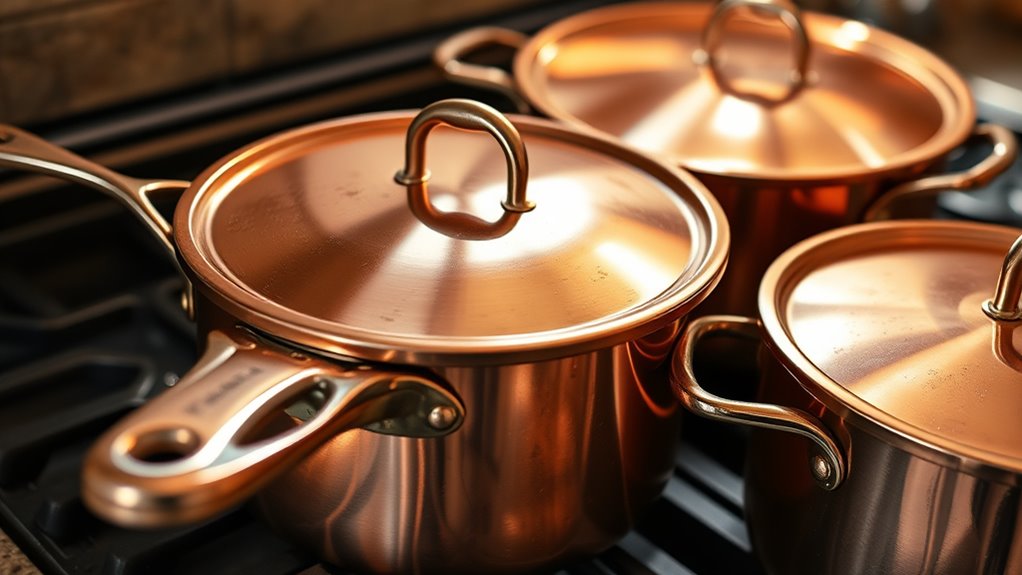
Balancing the stunning look of your copper cookware with its routine upkeep requires thoughtful care. To preserve its aesthetics, you need regular maintenance, including polishing every few months with lemon juice, salt, or specialized copper polish. This keeps tarnish and patina at bay, ensuring your cookware remains shiny and attractive. Additionally, re-tinning tin-lined pans every ten years helps prevent corrosion and maintains performance. Proper storage in a dry environment and using gentle utensils minimize scratches and surface damage, simplifying upkeep. While copper’s visual appeal enhances your kitchen decor, consistent cleaning and careful handling are essential to retain its beauty. By balancing these maintenance routines with your aesthetic goals, you can enjoy both the stunning style and longevity of your copper cookware.
Common Challenges With Copper Cleaning and Polishing
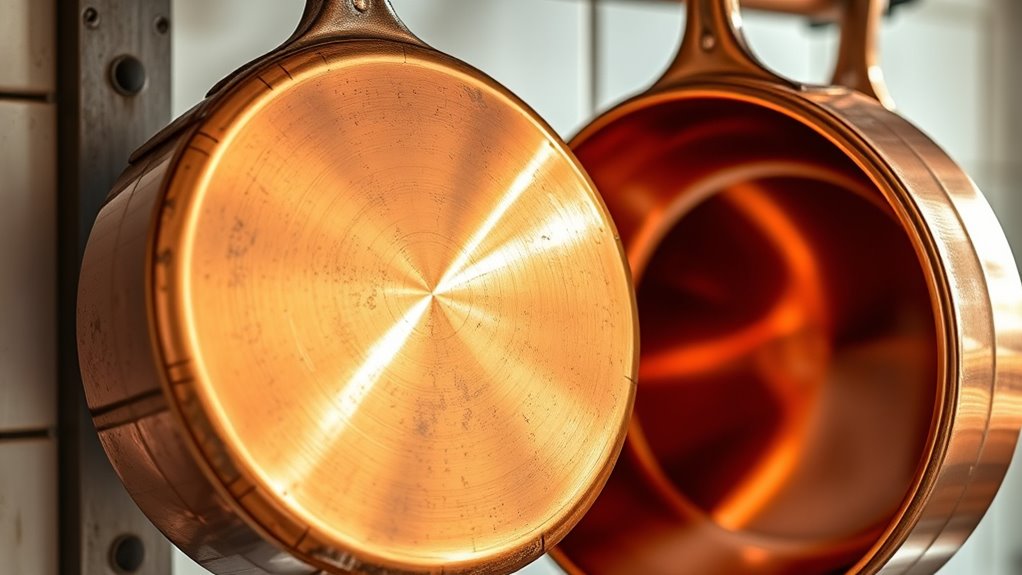
Over time, copper cookware naturally develops a dark brown or green patina due to oxidation, which can be difficult to remove completely. This tarnish often appears stubborn, requiring frequent polishing to maintain its shine. However, improper cleaning techniques can make things worse. For example, you might:
- Use harsh abrasives like steel wool that scratch the copper or damage the tin lining.
- Rely on commercial polishes that need multiple applications and vigorous buffing.
- Overuse lemon juice, vinegar, or salt, which can dull the surface or cause discoloration if not handled carefully.
These challenges highlight the importance of gentle, consistent cleaning and polishing. Without proper care, tarnish can become ingrained, making your copper cookware harder to restore to its original gleam.
When to Recondition or Restore Your Copper Pans
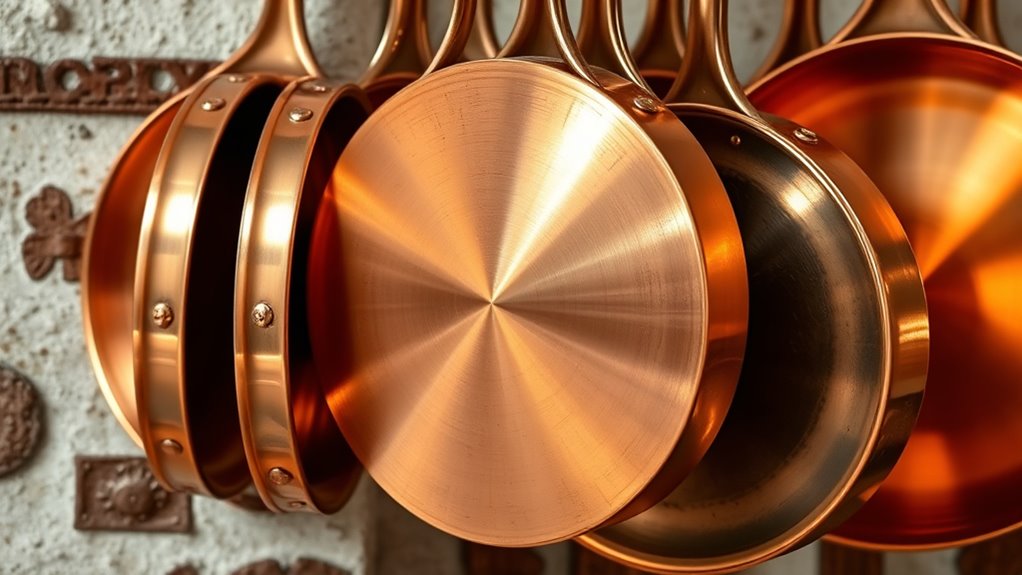
Your copper pans need reconditioning when you notice signs like persistent tarnish, uneven heating, or copper peeking through the lining. Re-tinning involves a professional process of applying a new tin layer and restoring shine, ensuring your pan performs like new. Keep an eye on cracks or dents inside to determine if it’s time for reconditioning or restoration.
Signs of Wear
Knowing when to recondition or restore your copper pans is essential to keep them performing their best. You might notice several signs of wear that indicate it’s time for some TLC.
- The copper develops a dark patina or tarnish that won’t come off with regular polishing, showing it needs a deeper clean.
- Visible copper peeking through the tin lining suggests the lining is worn out and may require re-tinning.
- Scratches, dents, or warping from heavy use can compromise both the appearance and function, signaling professional reconditioning could be necessary.
Discoloration or uneven coloring on the exterior is also a clue. When these signs appear, restoring your copper pans will help maintain their beauty and performance.
Re-tinning Procedures
Re-tinning is an essential maintenance step that you should consider every 10 to 15 years, depending on how often you use and clean your lined copper pan. When signs like copper peeking through, discoloration, or reduced non-stick properties appear, it’s time for re-tinning. This process involves a professional coppersmith melting and applying a fresh layer of tin onto the tin-lined copper surface, often coupled with polishing. Re-tinning restores the pan’s functionality and prevents copper from reacting with food, which can alter taste and color. Regular inspection of your tin-lined copper ensures you catch the need for re-tinning early. Proper care and timely reconditioning keep your copper cookware performing safely and efficiently, preserving both its beauty and utility over time.
Restoring Shine
Over time, copper pans naturally develop a patina and darkening that can dull their appearance. When this happens, it’s time for some restoration. To bring back their shine, you can:
- Use lemon juice, salt, or commercial copper polish for regular polishing every six months to maintain brightness.
- Apply a vinegar or lemon juice and salt paste for deeper tarnish removal, restoring the copper’s luster.
- Consider reconditioning the interior lining by re-tinning if the tin layer wears thin or gets damaged, typically every 10 years.
Proper cleaning, storage, and periodic polishing help prevent excessive tarnish and keep your copper pans looking stunning. Knowing when to recondition or restore ensures they stay functional and beautiful for years to come.
Alternatives for Those Who Love Copper but Fear the Maintenance

If you’re drawn to the look of copper but hesitant about its high maintenance, modern alternatives can give you the best of both worlds. Multi-layer clad cookware, like All-Clad, combines a copper layer with aluminum and stainless steel, offering excellent heat responsiveness with less upkeep. Many copper pans now feature a stainless steel lining that resists tarnishing, making them easier to clean and requiring minimal polishing. Copper-bottomed cookware with a stainless steel interior maintains great heat conduction while needing only occasional cleaning. These non-reactive, stainless steel-lined options are durable, compatible with all stovetops, and ideal if you want the beauty of copper without the high-maintenance commitment. Brands like MadeIn and House Copper deliver stylish, low-maintenance copper cookware that suits busy kitchens.
How Professional Chefs Make the Most of Copper’s Advantages
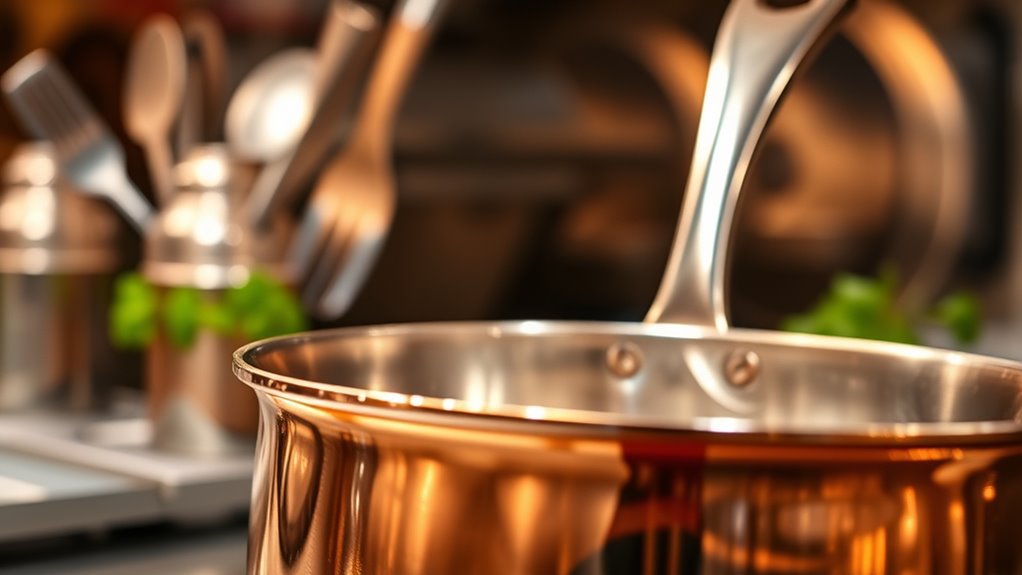
Professional chefs leverage copper’s quick heat response to fine-tune cooking temperatures instantly, ensuring perfect results every time. They use the visual cues from copper’s shiny surface to monitor their dishes closely and adjust as needed. This combination of rapid responsiveness and clear visual feedback helps them achieve precise control and consistency in their culinary creations.
Precise Temperature Control
Copper’s remarkable thermal conductivity gives chefs the ability to make tiny, immediate temperature adjustments, which is essential for delicate dishes like sauces and chocolates. With copper, you can:
- Sense even the slightest change in heat, responding quickly to prevent burning or overcooking.
- Achieve even heating across the pan, eliminating hot spots and ensuring consistent results.
- Manage multiple temperature zones seamlessly, perfect for complex, multi-step recipes.
This precise control allows you to fine-tune the temperature constantly, helping to maintain the ideal conditions necessary for textures and flavors. Copper’s quick heat responsiveness means you spend less time guessing and more time perfecting your dish. It’s the secret to mastering temperature-sensitive recipes with confidence and consistency.
Quick Heat Response
Thanks to copper’s rapid heat response, chefs can make instant adjustments to the pan’s temperature, ensuring precise control during critical moments. Its superior thermal conductivity allows quick changes, so you can avoid overcooking or burning. Copper responds within seconds, making delicate tasks like tempering chocolate or simmering sauces much easier. Imagine this:
| Temperature Change | Copper’s Response | Result |
|---|---|---|
| Increase heat | Fast heating | Quick boil, no lag |
| Decrease heat | Rapid cooling | Prevents burning |
| Sudden temperature shift | Immediate adjustment | Maintains perfect control |
| Even heat distribution | Consistent heat | No hot spots, uniform cooking |
This quick heat response helps chefs maintain consistent temperatures, maximizing copper’s advantages for precision and efficiency in the kitchen.
Visual Monitoring Benefits
The rapid heat response of copper cookware allows chefs to make precise adjustments, but they also rely heavily on visual cues to monitor their cooking. The reflective surface of a copper pan makes it easy to spot changes in color or sheen that signal heat levels. Here’s how you can use these visual cues:
- Notice color shifts—darker hues indicate higher heat, guiding you to lower the flame.
- Observe surface sheen—dull or matte areas reveal uneven heat distribution or hot spots.
- Watch for patina or tarnish—these subtle changes show prolonged high heat or boiling, prompting adjustments.
Thanks to copper’s superior heat conductivity, these visual cues give chefs confidence in controlling delicate techniques like sauce reduction or caramelization, ensuring perfect results every time.
Is Copper Worth the Extra Effort? Weighing Style Against Practicality
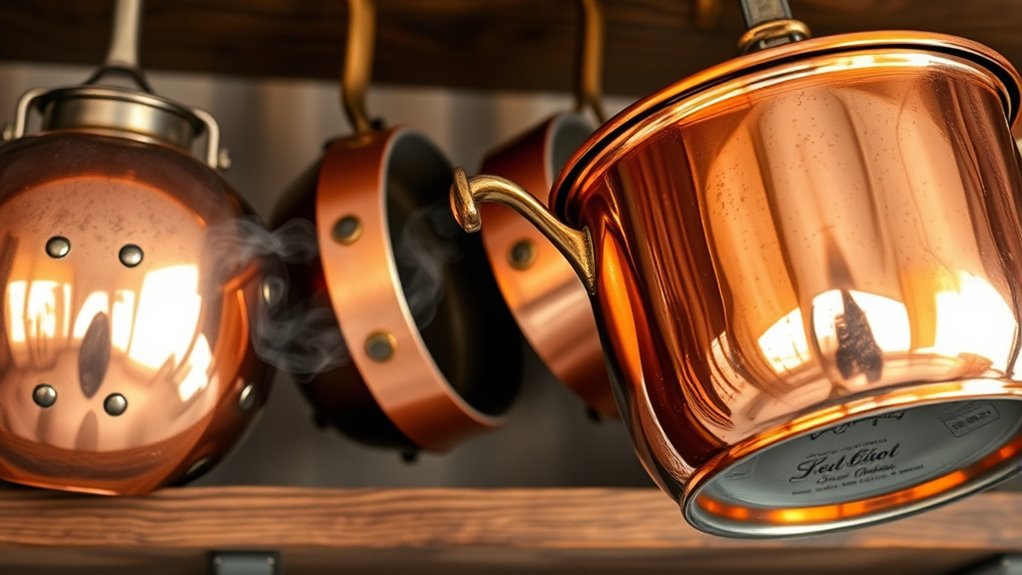
Deciding whether copper cookware is worth the extra effort depends on how much you value style over practicality. Copper pieces instantly elevate your kitchen’s look with their shiny, timeless appeal, making them perfect for display. However, maintenance demands can be high—you’ll need regular polishing with lemon juice, vinegar, or specialized cleaners to keep their bright finish. The lining material, like stainless steel or tin, influences upkeep; tin-lined pans require re-tinning roughly every decade. Plus, copper’s high cost, often exceeding $250 per piece, reflects its craftsmanship and premium quality. While copper offers superior heat responsiveness, tarnishing and patina mean you’ll need routine upkeep to preserve its aesthetic. If you don’t mind the extra maintenance, copper’s style might outweigh the practicality concerns.
Frequently Asked Questions
Are Copper Pans High Maintenance?
You wonder if copper pans are high maintenance. They do require regular polishing every six months to keep their shine and prevent tarnishing. The interior needs re-tinning roughly every ten years or when worn. Cleaning should be gentle with mild soap and soft sponges, and you need to avoid cooking acidic foods to prevent discoloration. Proper storage also helps, but overall, they demand more care than non-metallic options.
What Is the Downside of Copper Cookware?
The downside of copper cookware is its high maintenance, like tending a delicate garden that quickly tarnishes if neglected. You’ll need regular polishing to keep it shiny, and its reactive nature can alter flavors if the lining wears down. Plus, it’s costly and limits high-heat cooking. If you’re willing to invest time and money, it offers stunning style; otherwise, it might feel like a high-maintenance romance.
What Copper Pans Does Joanna Gaines Use?
You’re curious about which copper pans Joanna Gaines uses. She favors vintage and high-quality copper cookware, often from brands like Mauviel, known for their durability and timeless appeal. Gaines prefers well-aged or distressed copper pans with a rustic charm that complement her farmhouse style. She often displays these pans as decorative accents, highlighting their beauty and craftsmanship, blending functionality with aesthetic appeal in her kitchen decor.
What Is the Best Lining for Copper Pans?
When choosing the best lining for copper pans, you should consider durability and maintenance. Stainless steel linings are your best bet for everyday use because they’re durable and resistant to corrosion. If you prefer non-stick properties and don’t mind re-tinning every decade, tin linings work well. Copper with stainless steel is induction-compatible, offering responsiveness, while tin-lined copper pans are softer but more delicate.
Do Professional Chefs Use Copper Pans?
You might wonder if professional chefs use copper pans. The answer is yes. They favor copper because of its exceptional heat responsiveness and even heat distribution, allowing for precise temperature control. Chefs rely on copper for delicate tasks like sauces and tempering chocolate, where accuracy is vital. Despite needing more maintenance, its performance makes it a popular choice in high-pressure kitchens, helping chefs achieve consistent, perfect results.
Conclusion
Copper cookware offers stunning style that turns heads, but it demands constant care. If you’re drawn to its beauty but dread the upkeep, you might feel torn between elegance and effort. Yet, with a little routine maintenance, you can enjoy its benefits without the hassle. Ultimately, it’s a choice: embrace the glamour and work, or opt for easier alternatives. The decision depends on whether you crave show-stopping cookware or hassle-free functionality.








